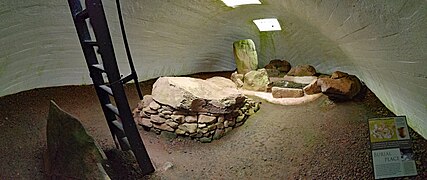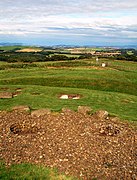Cairnpapple Hill
The Cairnpapple Hill is home to a prehistoric monument. The plateau on the 312 m high hill south of Linlithgow in West Lothian in Scotland was built between about 3000 and 1400 BC. Used as a burial ground and place of worship. The excavations in the late 1940s revealed the complete chronology of the elements on the hill.
The first activity on the hill consisted of the erection of three menhirs ( English Standing Stones ) in the center of an arc of small pits in which burned human bones lay, which in two cases were associated with bone needles . This burial ground was within a period around 3000 BC. An oval henge monument with a moat and wall in which a circle of 24 menhirs was built. Their former location is now marked by pits filled with gravel. A grave with a ceramic addition was found near one of the menhirs.
Centuries later, the type of use has changed and there were burials in a chamber grave ( English chambered tomb ) instead, which built the Henge in the western section, and was covered by a round hill. A burial with a menhir at one end lay beneath the small stone mound framed by curbs. The grave was the resting place of an important person, whose face was covered with some kind of mask. Next to her was a wooden club. A drinking cup was at the head and foot end. The cairn was later enlarged again to accommodate two urns .
The capstone of the chamber was replaced by a concrete dome to protect the graves and to make the chamber, which is accessed from above, accessible to the public.
- Cairnpapple Hill
literature
- Anna Ritchie, Graham Ritchie : Scotland. Archeology and Early History (= Ancient Peoples and Places . 99). Thames and Hudson Ltd., London 1981, ISBN 0-50002-100-7 .
Web links
Coordinates: 55 ° 55 ′ 40.3 " N , 3 ° 37 ′ 21.5" W.



